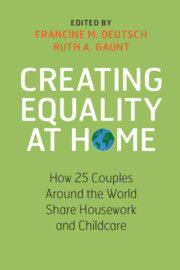Book contents
- Creating Equality at Home
- Advance Praise for Creating Equality at Home
- Creating Equality at Home
- Copyright page
- Dedication
- Contents
- Contributors
- Acknowledgments
- Development and Gender Equality in Participating Countries
- Setting the Stage
- 1 Introduction
- 2 Past and Current Research
- Consciously Creating Equality
- Violating Social Norms
- Prioritizing Family
- Drawing on Lessons from Families of Origin
- Using Government Policies
- What We Have Learned
- Index
- References
2 - Past and Current Research
from Setting the Stage
Published online by Cambridge University Press: 03 June 2020
- Creating Equality at Home
- Advance Praise for Creating Equality at Home
- Creating Equality at Home
- Copyright page
- Dedication
- Contents
- Contributors
- Acknowledgments
- Development and Gender Equality in Participating Countries
- Setting the Stage
- 1 Introduction
- 2 Past and Current Research
- Consciously Creating Equality
- Violating Social Norms
- Prioritizing Family
- Drawing on Lessons from Families of Origin
- Using Government Policies
- What We Have Learned
- Index
- References
Summary
Chapter 2 reviews the extant theory and research on domestic labor including scholarship on relative resources, time availability, gender ideology, national context, and doing gender. It then argues that all of these theories are inadequate to explain how some couples are able to achieve equality, and proposes instead to examine the everyday interactions by which couples undo gender.
Keywords
- Type
- Chapter
- Information
- Creating Equality at HomeHow 25 Couples around the World Share Housework and Childcare, pp. 8 - 28Publisher: Cambridge University PressPrint publication year: 2020
References
- 4
- Cited by



